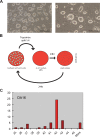Culture parameters for stable expansion, genetic modification and germline transmission of rat pluripotent stem cells
- PMID: 23213369
- PMCID: PMC3507162
- DOI: 10.1242/bio.2011029
Culture parameters for stable expansion, genetic modification and germline transmission of rat pluripotent stem cells
Abstract
The ability of cultured pluripotent cells to contribute to the germline of chimaeric animals is essential to their utility for genetic manipulation. In the three years since rat embryonic stem (ES) cells were first reported the anticipated proliferation of genetically modified rat models from this new resource has not been realised. Culture instability, karyotypic anomalies, and strain variation are postulated to contribute to poor germline colonisation capacity. The resolution of these issues is essential to bring pluripotent cell-based genetic manipulation technology in the rat to the level of efficiency achieved in the mouse. Recent reports have described various alternative methods to maintain rat ES cells that include provision of additional small molecules and selective passaging methods. In contrast, we report that euploid, germline competent rat ES and embryonic germ (EG) cell lines can be maintained by simple adherent culture methods in defined medium supplemented with the original two inhibitors (2i) of the mitogen-activated protein kinase (ERK1/2) cascade and of glycogen synthase kinase 3, in combination with the cytokine leukaemia inhibitory factor (LIF). We demonstrate genetic modification, clonal expansion and transmission through the germline of rat ES and EG cell lines. We also describe a marked preference for full-term chimaera contribution when SD strain blastocysts are used as recipients for either DA or SD pluripotent stem cells.
Keywords: 2i; chimaera; embryonic germ cell; embryonic stem cell; germline transmission; rat.
Figures





References
Grants and funding
LinkOut - more resources
Full Text Sources
Other Literature Sources
Miscellaneous

